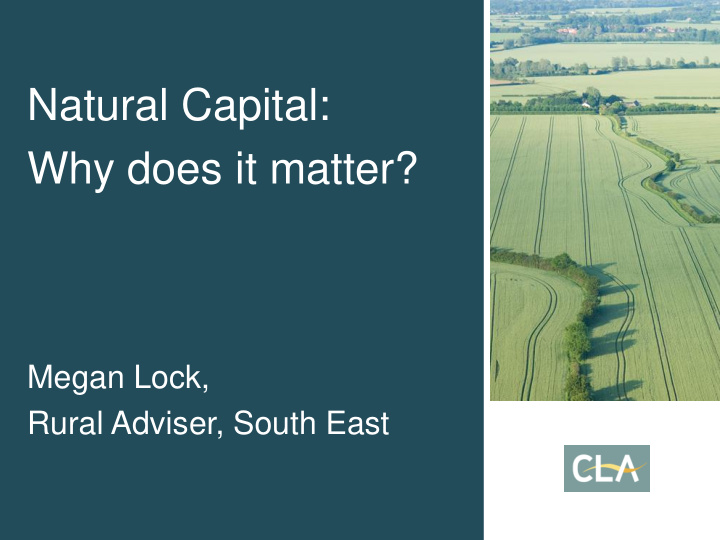



Natural Capital: Why does it matter? Megan Lock, Rural Adviser, South East
Content • What is Natural Capital? • Why does Natural Capital matter? • CLA’s interest and vision for the future • Post Brexit and new opportunities
What is Natural Capital?
Services Ecosystem ALL LIVING ORGANISMS GEOLOGY SOIL WATER AIR Services Ecosystem
Supporting Services Ecosystem Cultural Provisioning Services Services services Regulating Services
Supporting Services Hydrological cycle Natural succession Photosynthesis Soil formation / Nutrient cycling pedogenesis
Provisioning Services Renewable energy production Genetic resources Industrial and / or construction materials Fuel Shelter Wildlife habitat Biodiversity Soil
Regulating Services Water and flood regulation Climate regulation Air purification Erosion regulation
Cultural Services Noise reduction Aesthetic Spiritual Education and training Health and wellbeing Social / event venue Sense of place Historic monuments Site of archaeological remains Recreation
Renewable energy Water and flood production regulation Genetic resources Noise reduction Industrial and / or Education and Aesthetic Air purification construction materials training Social / event venue Spiritual Hydrological cycle Climate regulation Shelter Health and wellbeing Natural succession Wildlife habitat Fuel Biodiversity Sense of place Historic monuments Soil Erosion regulation Recreation A medium for facilitating Soil formation / primary production Nutrient cycling pedogenesis
Economic opportunities from ecosystem services Provisioning services already generate a market return – e.g. renewable energy Regulating services are closer or have a clearer route to market – carbon and water. Cultural and supporting services are more challenging to value and monetise.
What more could be done? • Not a budgetary black hole • Benefits of investing exceed the costs • Positive case but poorly understood and difficult to implement
• Underpins our economy and society • Foundation of rural economy • Enhances the lives of us all • Finite and under pressure which is increasing
CLA member investment in Natural Capital Environmental Improvements over 5 years Investment No investment 48% 52%
CLA member investment in Natural Capital Environmental Improvements over 5 years Stewardship other 45% 55%
Current investment options Limited in scope, scale and ambition. Most substantial option to support investment is Agri-environment schemes and Countryside Stewardship
Current investment options For every £1 spent on these schemes, £25 is gained in natural capital benefits
Other opportunities ? Groups or Farmer Do it alone? Clusters
CLA’s vision for Natural Capital by 2030 Recognition & rewarded – Maintaining and enhancing Investment is viable and attractive – rural business Improvements to water, biodiversity, flooding, carbon Support to invest in NC assets and have access to a range of tools
What is required to meet the vision? State is primary supporter – foundation to future policy Reduce policy and regulation barriers and improve policy Encourage private markets to invest
A new landscape post-Brexit The State of Nature report Develop policy outside the EU We need to work together, share ideas and experience
Summary Natural Capital is an asset which can provide benefits to you, your land, your business, the environment and society but we must work together to deliver
Thank you Megan Lock, Rural Adviser CLA South East 01264 313434 – megan.lock@cla.org.uk
Recommend
More recommend